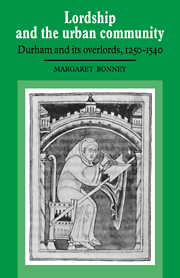Book contents
- Frontmatter
- Contents
- Acknowledgements
- List of abbreviations
- INTRODUCTION
- 1 URBAN ORIGINS: THE GROWTH AND DEVELOPMENT OF DURHAM TO 1250
- 2 THE URBAN LANDSCAPE OF DURHAM 1250–1540
- 3 DURHAM'S MEDIEVAL BUILDINGS
- 4 LANDLORD AND TENANTS: THE ECONOMIC RELATIONSHIP BETWEEN DURHAM PRIORY AND ITS URBAN TENANTS IN THE LATER MIDDLE AGES
- 5 TRADES AND OCCUPATIONS
- 6 LORDSHIP IN ACTION: THE MAINTENANCE OF LAW AND ORDER IN LATE-MEDIEVAL DURHAM
- CONCLUSION: LORDSHIP AND COMMUNITY: THE RELATIONS BETWEEN DURHAM AND ITS ECCLESIASTICAL OVERLORDS IN THE LATER MIDDLE AGES
- Appendix 1 Maps and plans of Durham
- Appendix 2 Tables
- Appendix 3 The dates of the bishops of Durham from 995 to the Dissolution
- Appendix 4 The obedientiaries of Durham Priory
- Appendix 5 The Durham courts
- Bibliography
- Index
1 - URBAN ORIGINS: THE GROWTH AND DEVELOPMENT OF DURHAM TO 1250
Published online by Cambridge University Press: 06 January 2010
- Frontmatter
- Contents
- Acknowledgements
- List of abbreviations
- INTRODUCTION
- 1 URBAN ORIGINS: THE GROWTH AND DEVELOPMENT OF DURHAM TO 1250
- 2 THE URBAN LANDSCAPE OF DURHAM 1250–1540
- 3 DURHAM'S MEDIEVAL BUILDINGS
- 4 LANDLORD AND TENANTS: THE ECONOMIC RELATIONSHIP BETWEEN DURHAM PRIORY AND ITS URBAN TENANTS IN THE LATER MIDDLE AGES
- 5 TRADES AND OCCUPATIONS
- 6 LORDSHIP IN ACTION: THE MAINTENANCE OF LAW AND ORDER IN LATE-MEDIEVAL DURHAM
- CONCLUSION: LORDSHIP AND COMMUNITY: THE RELATIONS BETWEEN DURHAM AND ITS ECCLESIASTICAL OVERLORDS IN THE LATER MIDDLE AGES
- Appendix 1 Maps and plans of Durham
- Appendix 2 Tables
- Appendix 3 The dates of the bishops of Durham from 995 to the Dissolution
- Appendix 4 The obedientiaries of Durham Priory
- Appendix 5 The Durham courts
- Bibliography
- Index
Summary
This city is famous throughout Britain, on its steep foundation, wondrously rising up about a rocky base. The Wear flows round it, a river with a strong current in whose waters live many kinds of fish … In the city, too, famous among men, lies Cuthbert the holy and blessed.
Early local legend as well as successive generations of monks and their priors, such as John Wessington (1416-46), fostered the belief that St Cuthbert himself had chosen the site of Durham. In 995, or thereabouts, as the community of St Cuthbert, carrying the precious body of their saint, wandered through the northern countries trying to avoid the worst ravages of the Danish invaders, they happened to pass a wooded place called Dunholm or Dunhelm. According to later accounts of the journey and to the tradition which grew around it, the bier of St Cuthbert suddenly became immovable, a clear sign from heaven that Dunholm was to be the saint's final resting place. Some four centuries later, the monks were still asserting that there was not ‘ a church, a chapel or a house’ built where the city and suburbs of Durham then lay before this almighty intervention. But, churlish though it may seem to throw doubts on St Cuthbert's reputation as Durham's founding father, there are strong indications that he was not the first to recognise the great potential of the site. Other chronicle evidence suggests that there may have been a community of farmers settled in the area before St Cuthbert led his followers, spiritually at least, to the site.
- Type
- Chapter
- Information
- Lordship and the Urban CommunityDurham and its Overlords, 1250–1540, pp. 9 - 36Publisher: Cambridge University PressPrint publication year: 1990



